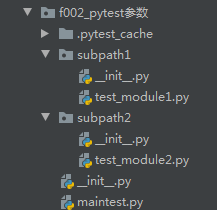以下的转载的内容:
本文介绍pytest.main运行测试用例的方法
pytest.main():main中传入不同的指令用以执行指定测试用例
-s: 显示程序中的print/logging输出
-v: 丰富信息模式, 输出更详细的用例执行信息
-q: 安静模式, 不输出环境信息
-k:关键字匹配,用and区分:匹配范围(文件名、类名、函数名)
示例

test_module1.py
def test_m1_1(): print('这是 subpath1/test_module1.py::test_m1_1') assert 1==1 def test_m1_2(): print('这是 subpath1/test_module1.py::test_m1_2') assert 2==2 def test_spec_1(): print ('这是 subpath1/test_module1.py::test_spec_1') assert 2 == 2
test_module2.py
def test_m2_01(): print('这是 subpath1/test_module1.py::test_m1_1') assert 1==1 class TestM2(): def test_m2_02(self): print ('这是 subpath2/test_module2.py::TestM2::test_m2_02') assert 1==1 def test_pp(self): print ('这是 subpath2/test_module2.py::TestM2::test_pp') assert 1 == 1
maintest.py
import pytest if __name__ == '__main__': # 运行当前目录下所有(test_*.py 和 *_test.py) pytest.main()
运行结果:
============================= test session starts ============================= platform win32 -- Python 3.6.6rc1, pytest-5.4.1, py-1.8.1, pluggy-0.13.1 rootdir: E:\study\python\study\BasicKnowledgePoints\s5_frame\f001_pytest_用例运行 collected 6 items subpath1\test_module1.py ... [ 50%] subpath2\test_module2.py ... [100%] ============================== 6 passed in 0.15s ==============================
重点来了:
1、运行指定路径下的用例
pytest.main(['./']) # 运行./目录下所有(test_*.py 和 *_test.py) pytest.main (['./subpath1']) # 运行./subpath1 目录下用例 pytest.main (['./subpath1/test_module1.py']) # 运行指定模块 pytest.main (['./subpath1/test_module1.py::test_m1_1']) # 运行模块中的指定用例 pytest.main (['./subpath2/test_module2.py::TestM2::test_m2_02']) # 运行类中的指定用例 pytest.main (['-k','pp']) # 匹配包含pp的用例(匹配目录名、模块名、类名、用例名) pytest.main(['-k','spec','./subpath1/test_module1.py']) # 匹配test_module1.py模块下包含spec的用例 pytest.main(['-k','pp','./subpath2/test_module2.py::TestM2']) # 匹配TestM2类中包含pp的用例
2.运行参数
pytest.main(['-s','./subpath1/test_module1.py']) # -s: 显示程序中的print/logging输出
运行结果:
subpath1\test_module1.py 这是 subpath1/test_module1.py::test_m1_1 .这是 subpath1/test_module1.py::test_m1_2 .这是 subpath1/test_module1.py::test_spec_1 .
pytest.main(['-v','./subpath1/test_module1.py']) # -v: 丰富信息模式, 输出更详细的用例执行信息
运行结果
subpath1/test_module1.py::test_m1_1 PASSED [ 33%] subpath1/test_module1.py::test_m1_2 PASSED [ 66%] subpath1/test_module1.py::test_spec_1 PASSED [100%] ============================== 3 passed in 0.06s ==============================
pytest.main(['-q','./subpath1/test_module1.py']) # -q: 安静模式, 不输出环境信息
运行结果:
... [100%] 3 passed in 0.06s
pytest.main(['-v','-s','./subpath1/test_module1.py']) # 多个参数组合
运行结果
subpath1/test_module1.py::test_m1_1 这是 subpath1/test_module1.py::test_m1_1 PASSED subpath1/test_module1.py::test_m1_2 这是 subpath1/test_module1.py::test_m1_2 PASSED subpath1/test_module1.py::test_spec_1 这是 subpath1/test_module1.py::test_spec_1 PASSED ============================== 3 passed in 0.10s ==============================
仅做记录
————————————————
版权声明:本文为CSDN博主「小白爱吃饭」的原创文章,遵循CC 4.0 BY-SA版权协议,转载请附上原文出处链接及本声明。
原文链接:https://blog.csdn.net/weixin_44006041/article/details/107934174